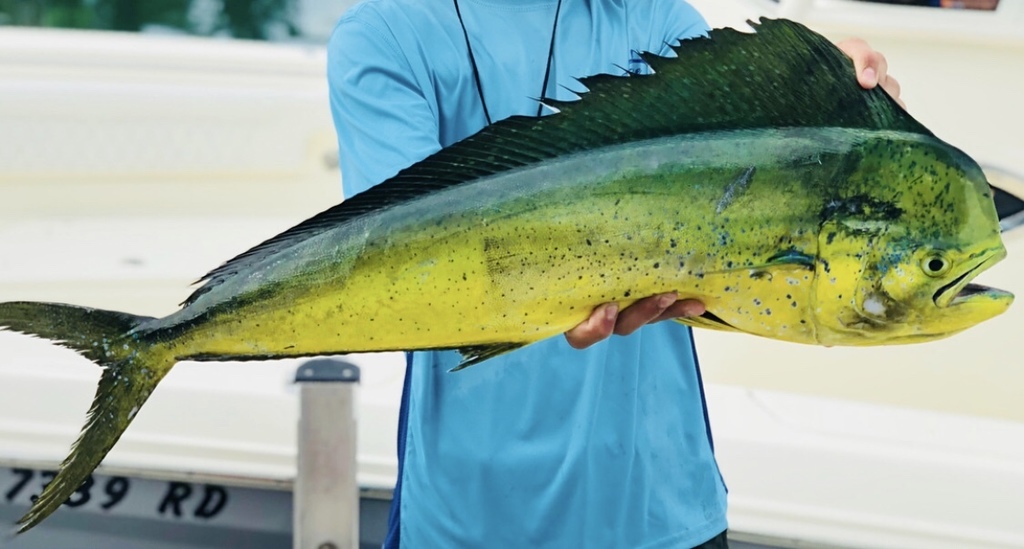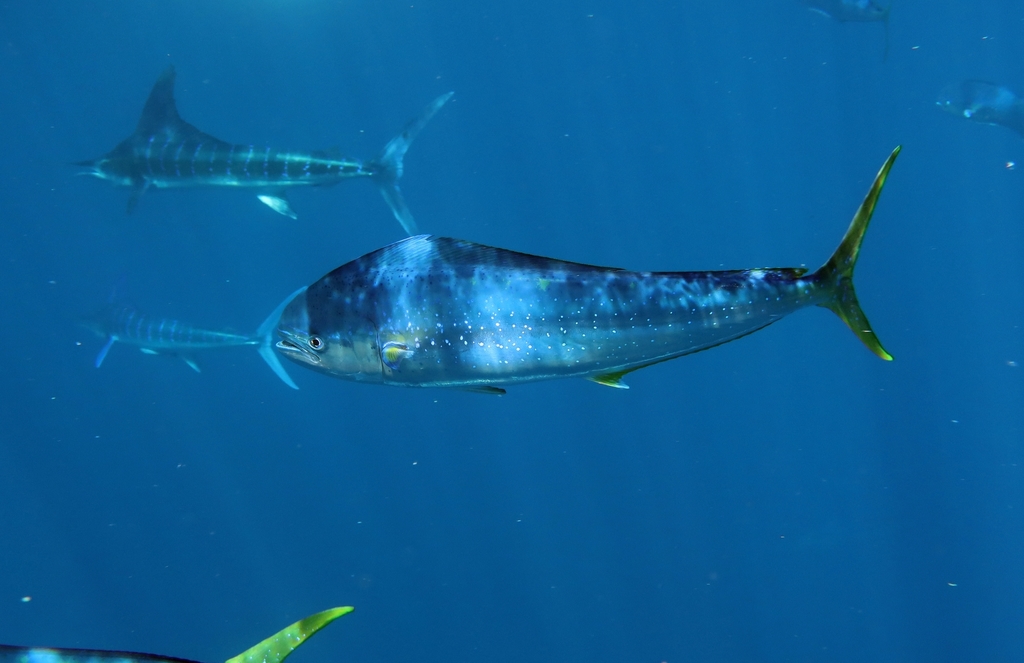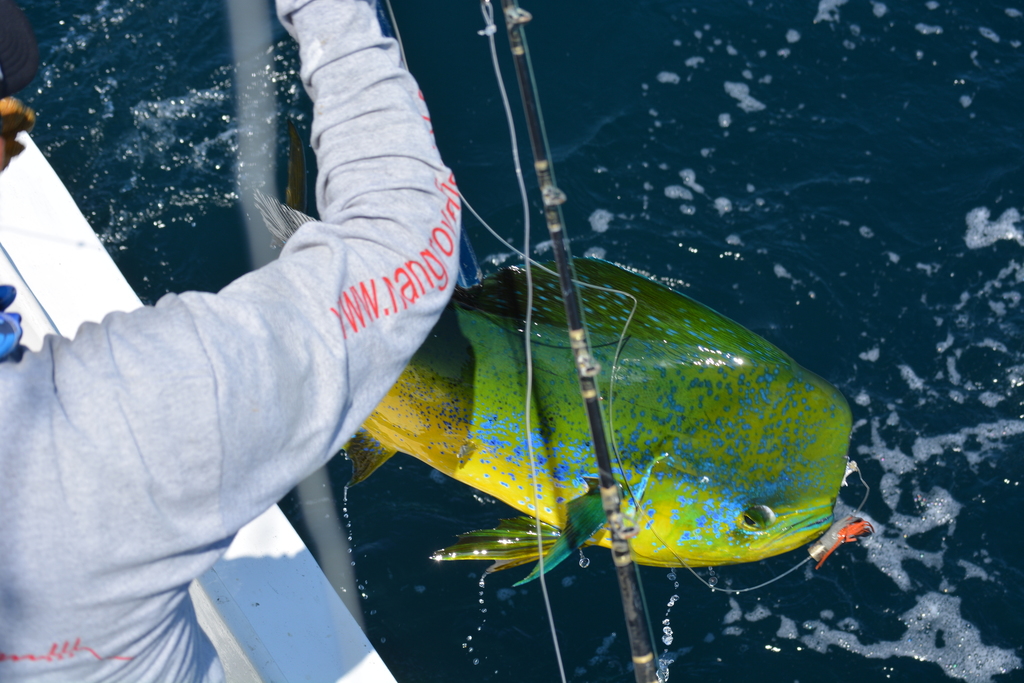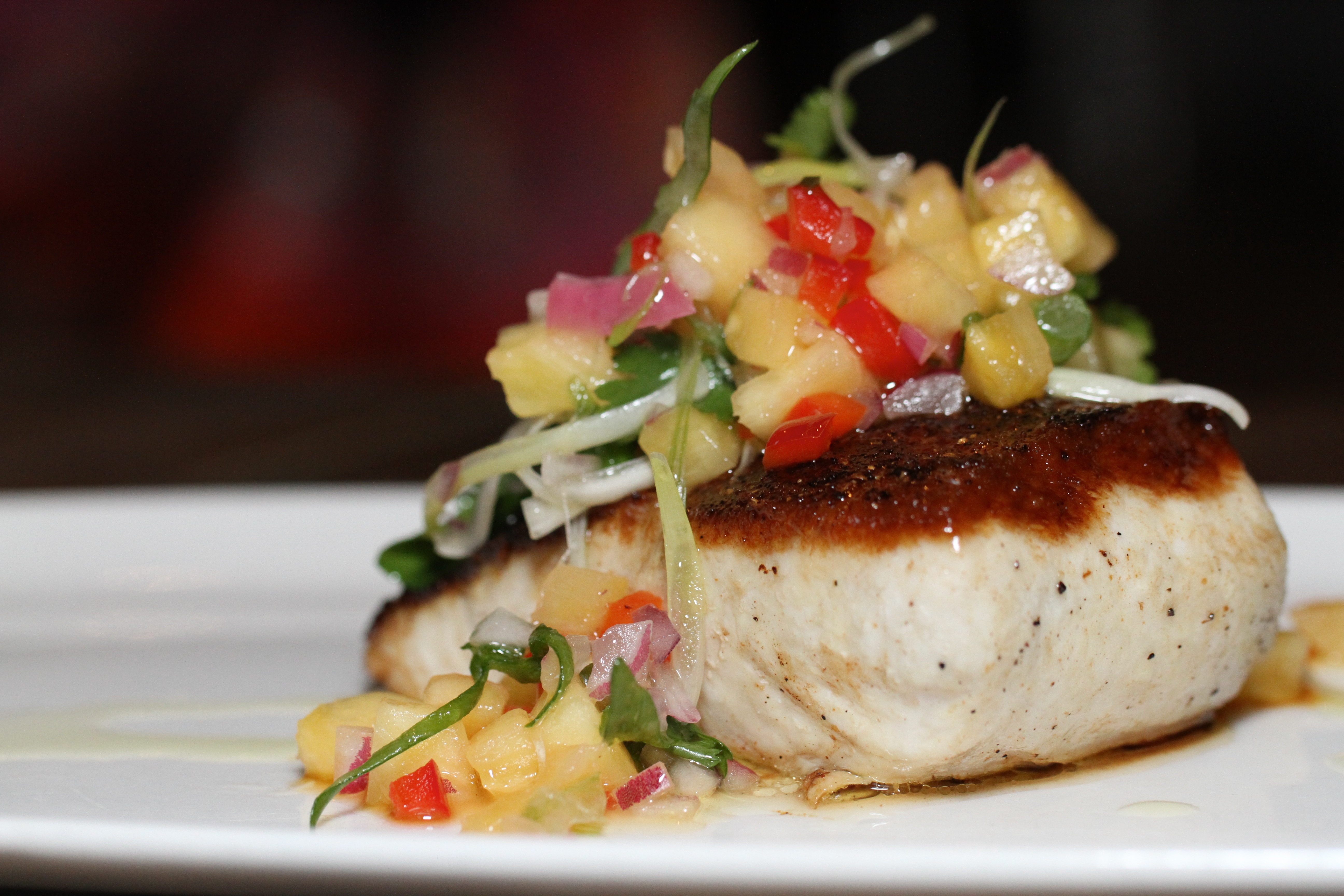Coryphaena hippurus
North Coast (Oregon Border to Point Arena)
North Central Coast (South of Point Arena to Half Moon Bay)
Central Coast (South of Half Moon Bay to Point Conception)
Santa Barbara (Point Conception to Point Dume)
South Coast (Point Dume to Mexico border)
Firm fish
Flakey fish
Wild caught

The Science

Taxonomic description
- Has a brightly colored back with an electric-greenish blue, its lower body is gold or sparking silver, and its sides have a mixture of dark and light spots. Its bright pattern fades almost immediately afater being caught. [1]
- Has a long body and blunt face, a forked caudal fin (tail), and a dorsal fin that runs the length of its body. [2]
- Distinguished from the pompano dolphin by the number of dorsal fin rays and a wide, square tooth patch on its tongue. [1]
- Averages 1 m (3 feet) in length, and can grow up to 2 m (6 feet). [2]
Distribution
- Distributed in tropical and subtropical waters throughout the Atlantic, Indian, and Pacific Oceans. [2]
- In the Eastern Pacific, found from Oregon and California south to Peru, and west to Hawaii and the U.S. Pacific Island territories. [2]
Life history
- Can live up to 5 years. [1]
- Sexually mature at 4-5 months old, spawns every 2-3 days througout its spawning season, releasing 33,000-66,000 each time. Its spawning season may be year-round. [1]
- Spawns in pairs rather than communally. [2]
Habitat
- Pelagic, lives in depths from 0-85 m (0-279 feet) near the coast or offshore under floating objects, such as large ships and large floating mats of sargassum. [2]
- Smaller dorado travel together in schools up to 50 individuals, and larger adult fish travel alone or in pairs. [2]
- Feeds during the day on small ocean fish (flying fish, sargassum fish), juvenile tuna, invertebrates (cephalopods, crabs), and pelgaic larvae or near shore, bottom-living species. [1]
- Predators include large tuna, marine mammals, sailfish, and swordfish. [1]
The Fishery

Seasonal availability
- Can be caught year-round. [1]
Regulatory and managing authority
-
Along the Pacific West Coast, this fish is managed by NOAA fisheries and the Pacific Fishery Management Council (established by the Magnuson-Stevens Act) through the West Coast Highly Migratory Species Fisheries Management Plan. [1]
-
As established by the Marine Life Management Act, the California Department of Fish and Wildlife collects data on this fishery through the Pelagic Fisheries and Ecosystems Program. [13,14]
Gear type
- Usually caught by handlines and troll lines. [1]
- Catching pelagic species by longline is not allowed in California. [3]
Status of the fishery
- Although heavily fished by recreational and commercial fishers, the dorado reproduces and matures quickly (has high fecundity), which has protected it so far from overfishing. Although the population has not been formally assessed, it is assumed to be stable and is considered a species of least concern for overfishing. [1]
Potential ecosystem impacts
- Typically, longline fishing in open ocean poses bycatch risks for sea turtles and marine mammals, which was a main consideration for the continued ban on pelagic longline fishing in California. [3,4]
- Trolling and handline fishing have very little bycatch risk and have little to no impact on the environment. [5]
The Seafood

Edible portions 
- Typically only the meat is consumed. [1]
Description of meat
- When raw, meat is pink to grayish-white, and has dark meat along the lateral line. It turns an off-white color when cooked. [1]
- Has a sweet, mild flavor. [1]
- It is a lean meat and is firm with large, moist flakes. [1]
Culinary uses
- Dorado is often grilled, fried, baked, steamed, or sautéed. [6]
- For a recipe for ginger glazed dorado, visit Allrecipies. [9]
- For a Filipino recipe for Mahi-Mahi Paksiw, visit Panlasang Pinoy. [15]
Nutritional information
- Nutritional information for 100g of cooked dorado are available on the table at the right. [8]
Toxicity report
- No toxins to report.
Seasonal availability
-
Available year-round. [1]
References
[1] NOAA Fisheries. 2020. Pacific Mahimahi. Fishwatch. Web. https://www.fishwatch.gov/profiles/pacific-mahimahi?_ga=2.204128856.9549.... Accessed 15 July 2020.
[2] Florida Museum. n.d. Dolphinfish. Florida Musem. Web. https://www.floridamuseum.ufl.edu/discover-fish/species-profiles/corypha.... Accessed 15 July 2020.
[3] NOAA Fisheries. 2019. California Pelagic Longline Final Rule. Web. https://www.fisheries.noaa.gov/action/california-pelagic-longline-final-.... Accessed 16 July 2020.
[4] NOAA Fisheries. 2019. Fishing Gear: Pelagic Longlines. Web. https://www.fisheries.noaa.gov/national/bycatch/fishing-gear-pelagic-lon.... Accessed 16 July 2020.
[5] Monterey Bay Aquarium Seafood Watch. n.d. Fishing and Farming Methods. Web. https://www.seafoodwatch.org/ocean-issues/fishing-and-farming-methods#:~.... Accessed 16 July 2020.
[6] This Fish. n.d. Traceable species: Mahimahi. Web. https://thisfish.info/fishery/species/mahimahi/. Accessed 16 July 2020.
[7] Greenpeace. n.d. Mahi Mahi. Web. https://www.greenpeace.org/usa/oceans/wildlife-facts/mahi-mahi/. Accessed 16 July 2020.
[8] Self. n.d. Fish, dolphinfish, cooked, dry heat Nutrition Facts and Calories. Web. https://nutritiondata.self.com/facts/finfish-and-shellfish-products/4216/2. Accessed 20 July 2020.
[9] Allrecipies. Ginger glazed mahi mahi. Web. https://www.allrecipes.com/recipe/45833/ginger-glazed-mahi-mahi/. Accessed 24 July 2020.
[10] AFTCO. 2017. Photo of dorado in water with floating algae bits. Digital image. Web. https://aftco.com/blogs/news/how-fast-can-dolphin-fish-mahi-mahi-grow. Accessed 27 July 2020.
[11] Ocean Blue. 2018. Photo of fisherman with dorado. Digital image. Web. https://www.oceanbluefishing.com/magazine/inspiration/facts-about-mahi-m.... Accessed 27 July 2020.
[12] Lingerman, J. and Buckley, C. 2019. Photo of mahi mahi filets cooked with lemon and browned butter on skillet. The Kitchn. Digital iamge. Web. https://www.thekitchn.com/mahi-mahi-22931939. Accessed 27 July 2020.
[13] Marine Life Management Act. n.d. California Department of Fish and Wildlife. Web. https://wildlife.ca.gov/Conservation/Marine/MLMA. Accessed 24 August 2020.
[14] Overview of the Pelagic Fisheries and Ecosystems Program. n.d. California Department of Fish and Wildlife. Web. https://wildlife.ca.gov/Conservation/Marine/Pelagic#52132542-overview. Accessed 9 December 2020.
[15] Merano, V. Panlasang Pinoy. n.d. Mahi-Mahi Paksiw Recipe. Web. https://panlasangpinoy.com/mahi-mahi-paksiw-recipe/. Accessed 13 January 2021.
[16] molly_jones. iNaturalist. 2019. Digital image. Web. https://www.inaturalist.org/observations/22198659. Accessed 16 February 2021.
[17] Kang, A. iNaturalist. 2017. Digital image. Web. https://www.inaturalist.org/photos/86517410. Accessed 16 February 2021.
[18] Ramírez, A. iNaturalist. 2014. Digital image. Web. https://www.inaturalist.org/observations/23935993. Accessed 16 February 2021.
[19] Hungry Dudes. flickr. 2011. (Roast) Sautéed Mahi Mahi (2). Digital image. Web. https://flickr.com/photos/twohungrydudes/5552940692. Accessed 16 February 2021.
